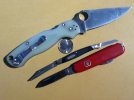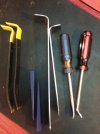This comment from ZKnives about M390, applies equally to derivative steels CTS-204P/CPM20cv, and is repeated for those steels. Note the highlighted.
Have folks sharpening these steels found this to be the case? I have put about a 12 dps on an M390 blade, and have not seen issues yet, but this blade has not been subjected to hard use either.
Have folks sharpening these steels found this to be the case? I have put about a 12 dps on an M390 blade, and have not seen issues yet, but this blade has not been subjected to hard use either.
M390 MicroClean(Bohler-Uddeholm) - Bohler-Uddeholm martensitic Chromium steel, made using their 3rd generation PM process. M390 features very high wear and corrosion resistance. Fine grained alloy, popular choice for high end folders and small fixed blades. working hardness up to 62HRC. Excellent performance with both, coarse and high polished edges. You still need about 15° per side edge to get the best performance and edge holding. Thinner than that, and you will run into the issue with the thin edge not being able to support all those carbides to make the edge perform. Working hardness can reach 62HRC, and most of the production knives I've seen are in 60-62HRC range. Overall, it is of the best performers as far as corrosion and wear resistance go, and because of that it is a popular choice for high end, and the limited edition knives. Aside from very good edge holding ability, maintaining the edge is very easy. And one more thing worth noticing, there's no stubborn burr forming during sharpening, therefore, there's no risk to form a wire edge either.


